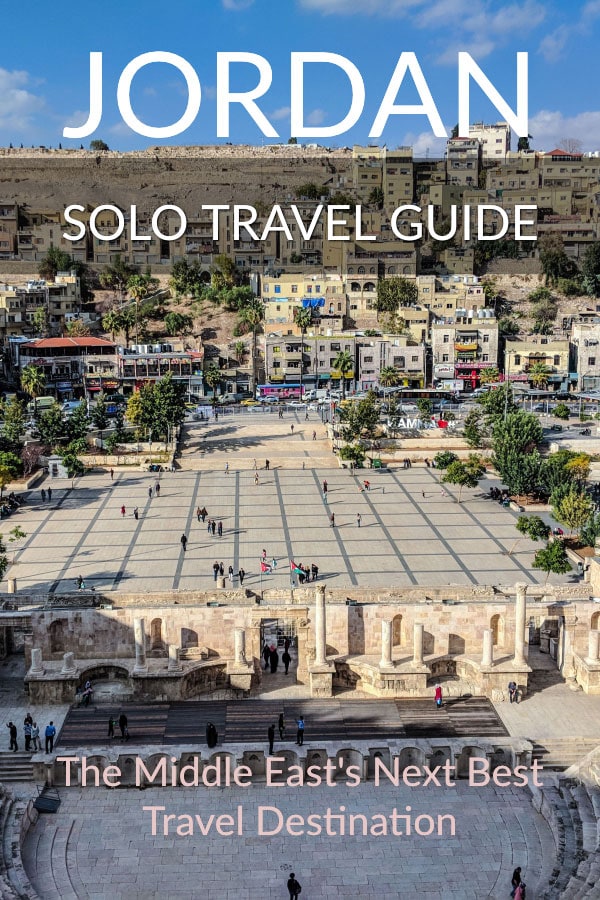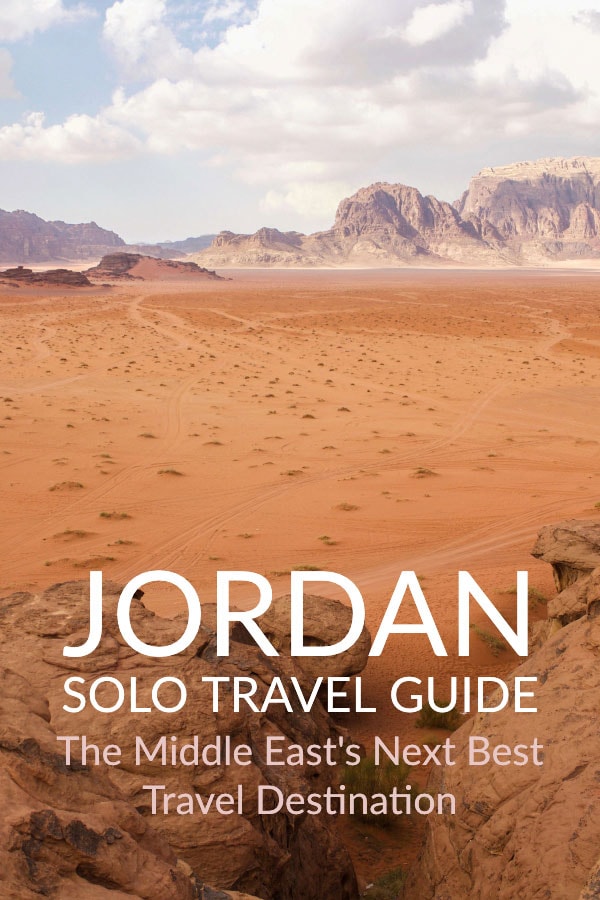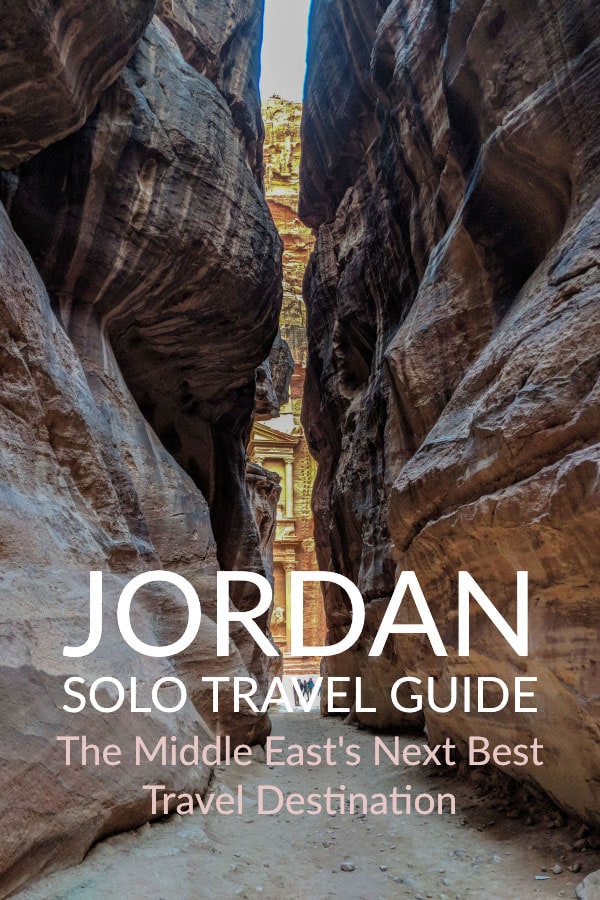Jordan flies under the “next best travel destination” radar most of the time. The name might be familiar but it’s often heard in the
In this post, I’ll give you some great tips on the major sites like Petra and Wadi Rum. I’ll also discuss a few practicalities like getting around, where to stay in Amman and what to do there, and the kinds of things to watch out for in Jordan.
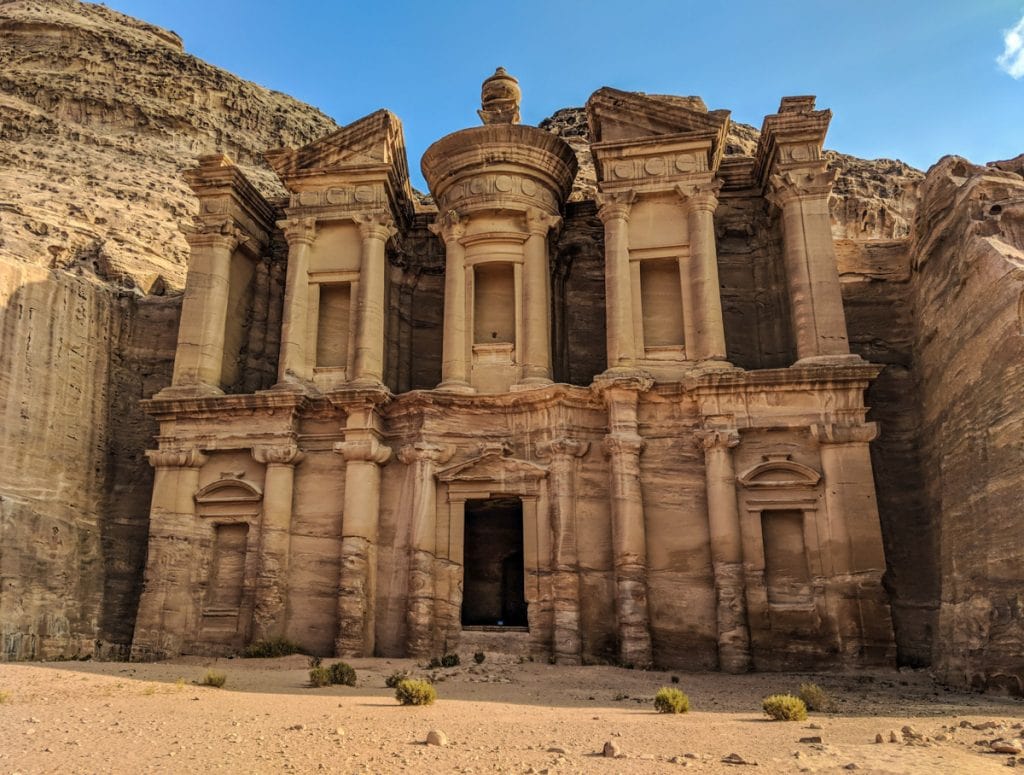
The Magnificent and enormous Cathedral of Petra 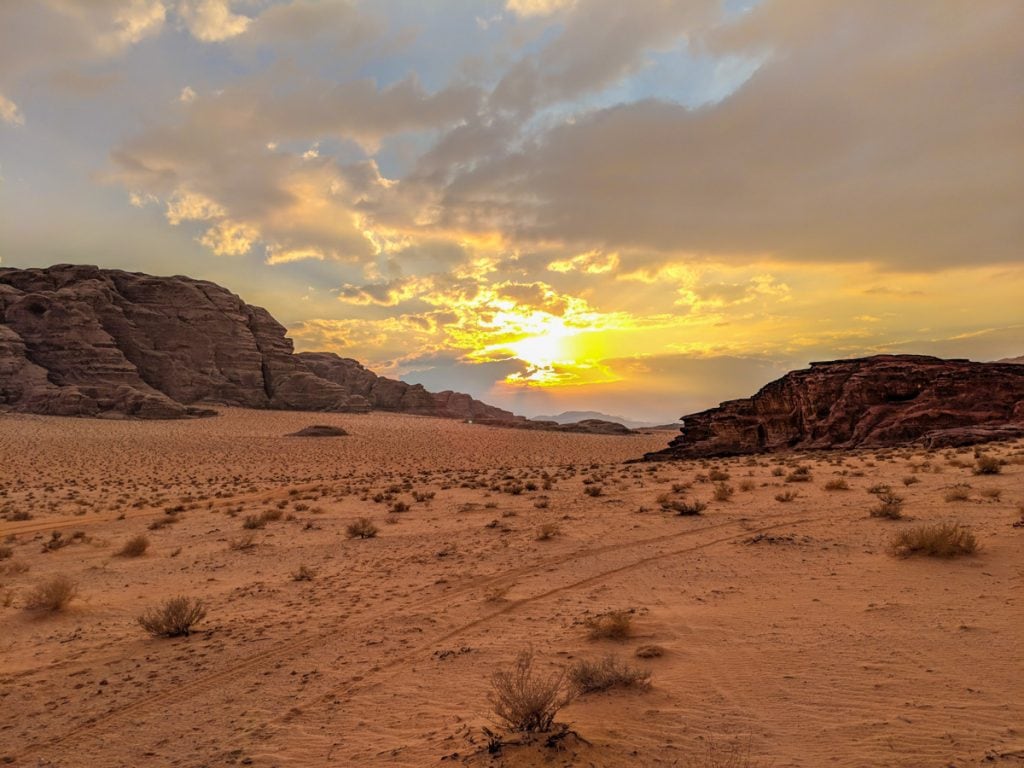
Sunset in Wadi Rum 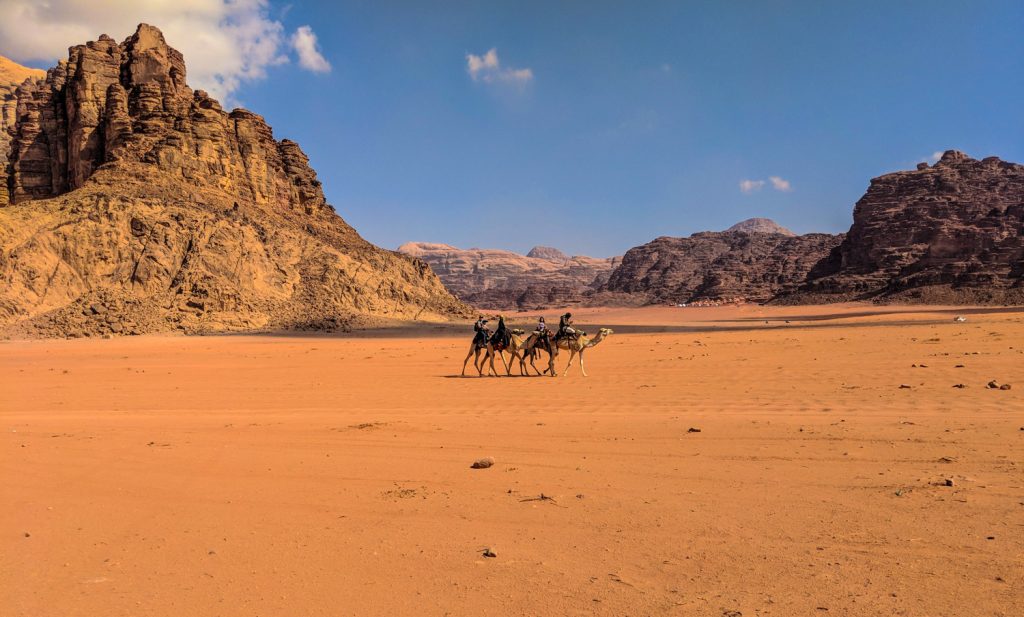
Camels in Wadi Rum, Jordan 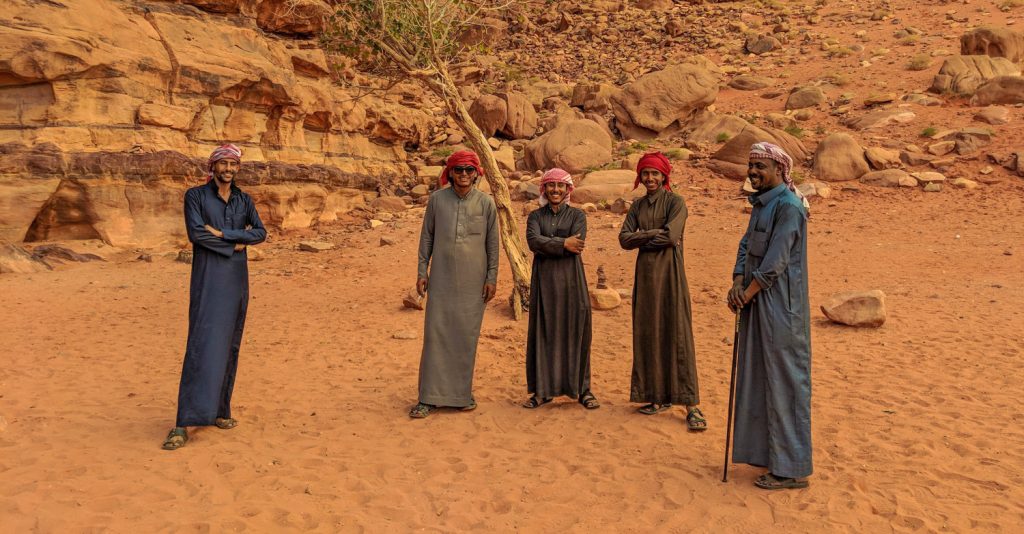
Bedouin tour guides in Wadi Rum near Khazali canyon 
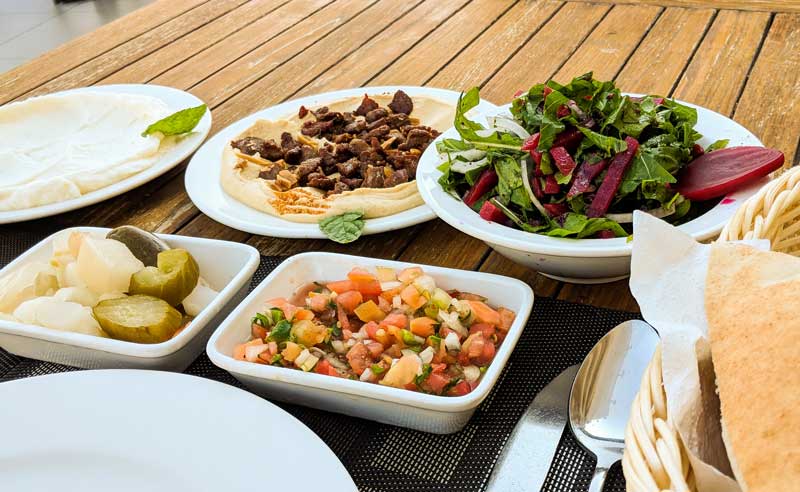
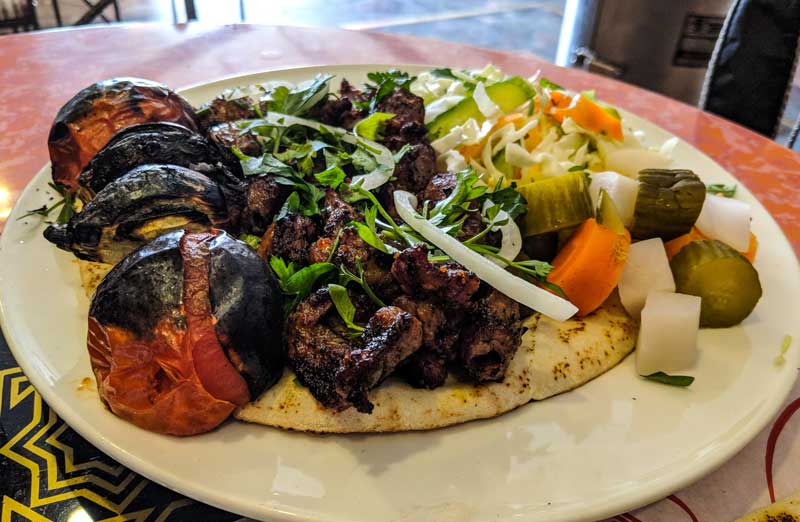
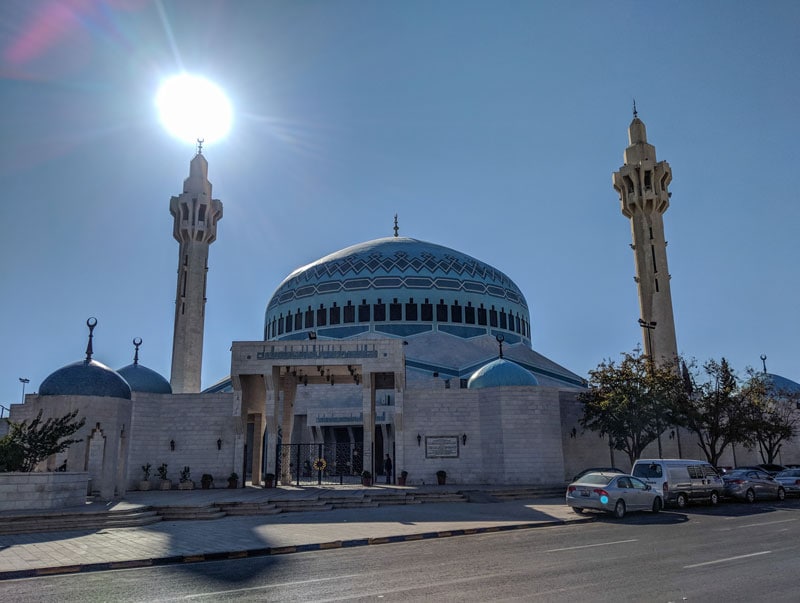
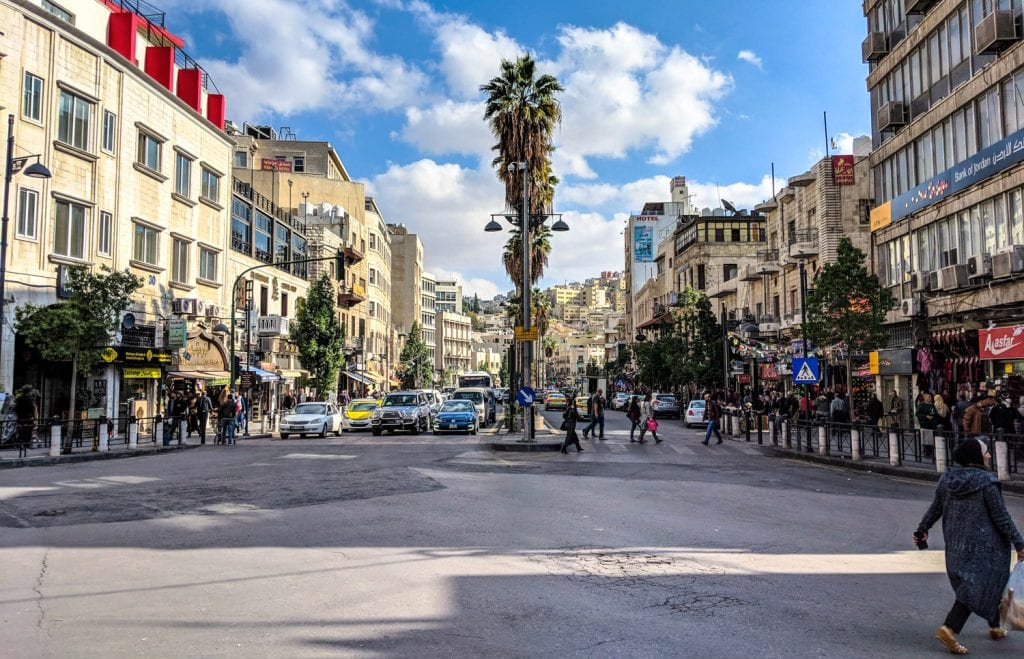
The City Centre of Amman 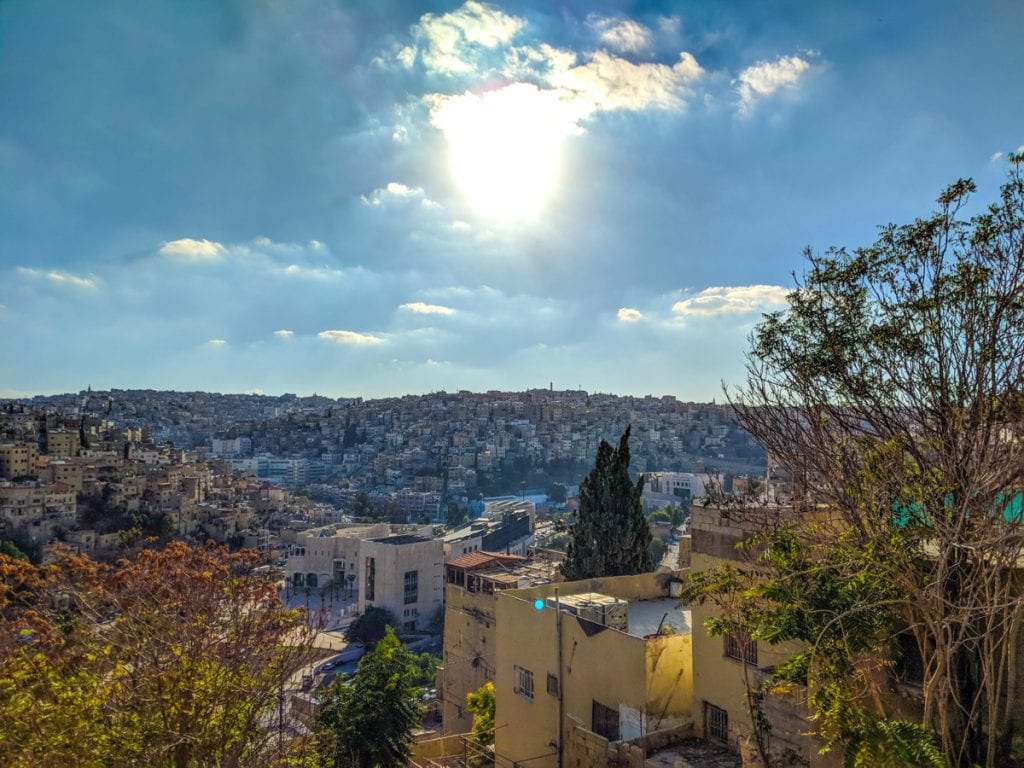
Cloudy view of the city of Amman, the capital of Jordan 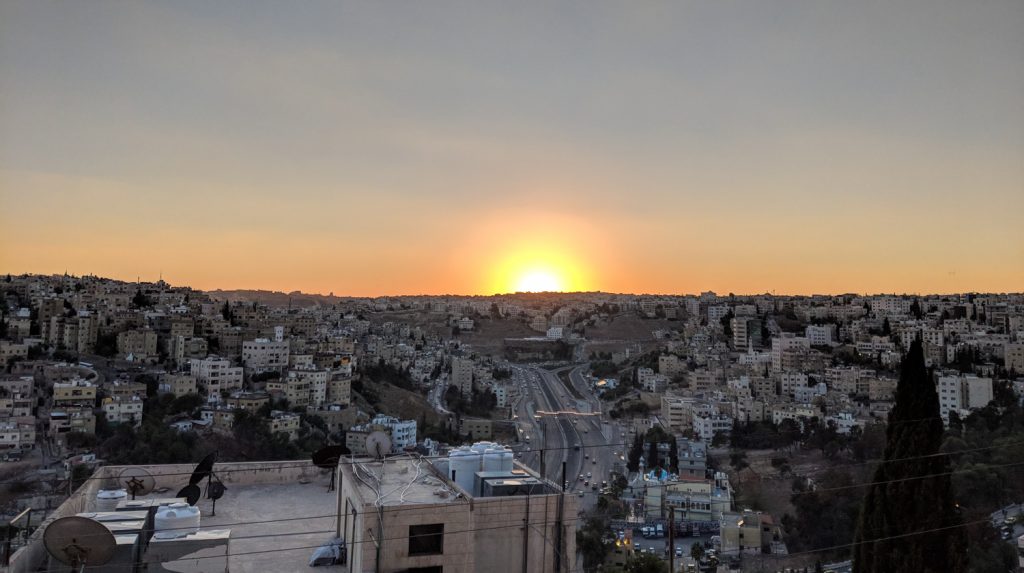
Sunset over Amman 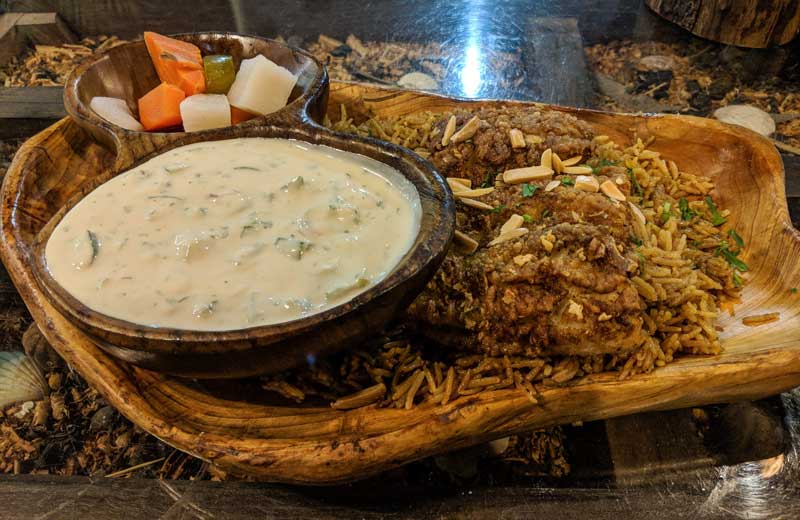
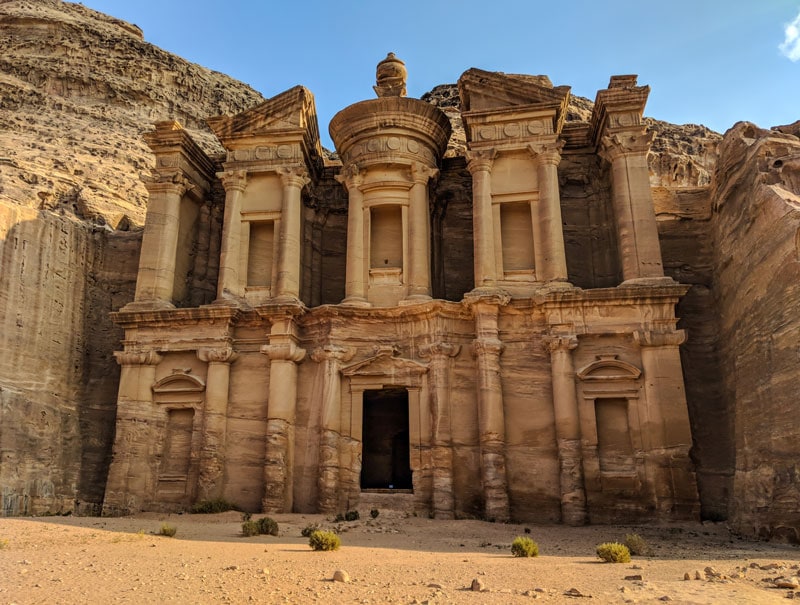
I’ve also included some short anecdotes from my recent trip to Jordan. Check the blue boxes. Enjoy Jordan!
Why Visit Jordan?
The country’s position at a critical point on the Silk Road, its proximity to Syria and Iraq, and the buffer zone between Israel and Arab nations in the Middle East means that Jordan plays an important part in international politics. The Romans ruled here for four centuries and the rich history of the region is visible everywhere.
Jordan has a lot to offer in a small space
During the last 60 years, Jordan has been a place of relative peace. King Hussein, the revered head of state between 1952 and 1999, acted as a peace broker in the region.
Despite the political stability, incredible history and natural beauty, Jordan is still finding its feet in the travel & tourism sector.
News of the region on international television and internet channels affects tourist numbers. Many people lump Jordan in with the war zones, refugee camps, and dictatorships of neighbouring countries. Thanks to the reports of conflicts in that part of the world, tourists to the region are a little more adventurous.
Epic Landscapes & Fewer Tourists
If you’re looking for a less touristy Egypt, Jordan is the next best thing. Combining beautiful landscapes with the history and physical reminders of thousands of years of settlement, Jordan is a small country with a lot to offer. And in case you didn’t know, scenes from the movies Lawrence of Arabia and Indiana Jones and the Temple of Doom filmed here. In “Lawrence”, David Lean’s epic movie, Wadi Rum stood in for, well, Wadi Rum in 1916. Watch the movie to get an idea of just how beautiful and barren this part of the world can be. The Temple of Doom contains a scene in which Indiana Jones enters the Treasury in Petra. I’d guess that this single scene alone sparked a huge increase in interest in not only Petra, but Jordan and the Middle Eastern region.
http://nomadflag.com/visit-amman-jordan/But that’s not all, Jordan has one side of the Dead Sea, the Jordan River, the spectacular Roman ruins of Jerash, the tourist resort of Aqaba, and the buzzing capital of Amman.
Best time to visit Jordan
For the coolest temperatures and fewest tourists, visit during the winter months of December, January, and February. This is also the rainiest time of year. The further north you go, the cooler the weather in winter. Aqaba can bathe in 20 degrees C while Amman freezes in the winter months.
July and August (visitor low season) see fewer tourists but the hottest average temperatures. You’ll also get the longest days and the most guaranteed hours of sunshine.
Divers should head to the southern coast between September and November.
Currency: Jordanian Dinar.
Sometimes written as JOD or JD. Pronounces Jay Dee as in “The meal cost ten Jay Dees”
Is the Jordan Pass Worth it?
A definitive yes. If you plan to spend more than one day in Jordan, the pass will save you plenty of money. The Petra entrance fee alone will cost you almost as much as the Jordan Pass. And holders of the Jordan Pass have their tourist visa waived at immigration (as long as you stay for at least three nights in the country).
There are three categories of pass: Wanderer, Explorer, and Expert. I opted for the Jordan Explorer, which gives you 2 days in Petra. The number of days in Petra is what determines the pass you take.
The Jordan Pass is great value. If you’re staying for longer than a day, it’s a must-have.
1 day, get the Wanderer, 2 days Explorer, 3 days Expert. The other benefits are the same across the three categories
What else do you get?
Entrance to Jerash, Wadi Rum, the Amman Citadel, Umm Quays, the Roman Theatres in Amman, the Lowest Place on Earth museum and many more.
The Jordan Pass will save you money and time. Just show your pass at the entrance to any site (most of them) that accepts the pass and walk straight through. Keep a digital copy on your phone and show it to the officials.
Note: the pass expires two weeks after first use.
How to get to Jordan
By Air
If you’re based in Europe (or you make a continental connection), you’re in luck. As of late 2018, Ryanair is running flights to the Red Sea port town of Aqaba from major European cities. It’s a cheap way to get to a country not considered a budget destination.
There are direct flights from the following cities to Aqaba: Athens, Cologne, Rome Ciampino, Sofia.
To Amman, there are direct flights from Bologna, Brussels, Bucharest, Budapest, Krakov, Malta, Milan Bergamo, Paphos, Prague, Vienna, Vilnius, Warsaw Modlin
These flights are great value (I grabbed a €9 flight from Rome to Aqaba and a €15 from Amman to Budapest). The taxis to the airports were more expensive in both cases.
There are two international airports in Jordan
- Queen Alia International Airport, a modern, recently refurbished building, lies 40km south of Amman. The best way to get to the capital is by taxi.
- The other airport is King Hussein International Airport, north of Aqaba. A small airport but efficient and within easy reach of Aqaba city.
By Car
Driving over from Israel is possible but it can sometimes be a circuitous trip. The geography of the mountains, the sea, and border crossings means you can only cross over at certain points. There are three border crossings only.
Getting from Jerusalem to Petra, for example, is a 450km journey through the far north or far south of the country. Flying might be the best option.
There’s a 10 JOD fee to pay at land border crossings when entering or leaving the country.
By Sea
You can also arrive in Jordan by Sea. Many travellers visit Jordan after visiting Egypt by taking the short trip from Taba to Aqaba. At $90 USD for a return trip, it’s not quite backpacker-friendly, but the alternative is to travel through Israel, which will work out similar in price once you spend time at borders and pay for travel. Israeli stamps on your passport might also cause you problems if you travelling to other Arab states (Egypt and Jordan exempted) so be careful with this route.
The only disadvantage is with taxi transport to and from major sites. If you take cabs alone you might find you spend more than you budgeted for. Ask your hotel or hostel manager or front desk if they know of other tourists that might share a cab.
Getting Around Jordan
The roads are of a high standard and the driving isn’t too bad. However, Jordan’s tourism infrastructure is still lacking. Plan your travels and avoid wasting time.
By Bus
Jordan websites are stuck in 1997 so don’t expect to get much more than cursory information from them. And don’t expect online booking systems. Wherever possible book through a provider you already know and trust.
Taxis are the main transport option for tourists. Unfortunately for budget travellers, taxis in the country are not cheap. And drivers almost always smoke cigarettes. One after the other. It’s not a great travel experience.
The bus from Petra to Amman drops you in the southern part of the city. You must get another taxi from there (or navigate a long bus journey and connection) to get to the centre of Amman. It should cost around $5 but if you get quoted higher, shop around. Ask the bus driver before you get off for the actual price.
If you plan on taking buses in the cities give yourself lots of time and expect to do a lot of chatting with locals (a good thing, in my book). If you’re pressed for time, I’d suggest avoiding bus travel.
By Rental Car
Renting a car is a good option. The driving here isn’t half as bad as in places like Egypt, Saudi Arabia, or Iran. Self-driving wins as the most practical way to get around Jordan. Driving allows you to jump off at stops that only tour buses visit. You can spend as long as you like (or as short as you like) at the dead sea. Getting from Aqaba to Petra or Petra to Amman is twice as fast with your own car.
Try Europcar for consistently good rates.
By Bicycle & Train & Air
Cycling is also possible and is a great way to get around the country between major towns. The Cycling Jordan Facebook page is a good place to start if you’re looking for more info. Keep in mind that biking around the cities will reduce your chances of living to a ripe old age.
There aren’t any (regular) trains in Jordan, which is a pity as it’s a beautiful country for a long train ride.
Flying between Amman and Aqaba is quick (30 minutes) and cheap (less than 100 USD) and is a viable option for avoiding backtracking.
Where to go – Jordan Tourist Attractions
The big six places to visit in Jordan are
You could also add Jerash in here but it’s not as well known as the other three. If you’re short on time visit these three. If you can only choose two, skip the Dead Sea.
Costs
Jordan is not a backpacker destination, by any means. Even for Europeans, the Jordanian Dinar is strong (on a par with the British pound) and costs are similar, if not more expensive than in Europe.
Turkish coffee will cost you anything from €0.50 ($0.60) to €1.50. But Turkish Coffee is an acquired taste. A regular coffee (Americano, Cappuccino, or Espresso from a machine) will set you back anything from €2 to €5. And the coffee is poor quality.
Public transport is cheap but runs at its own schedule. Tour buses and private buses are the most common transport most visitors around the country. Independent travellers are not the target demographic. Taxis are the most convenient way to travel but you can expect to pay accordingly.
Buses that travel between major centres like Aqaba and Petra or Petra and Amman leave when all seats fill up. You might wait a long time before you even start your journey. The journey from Petra to Amman by bus costs around US$10. A taxi costs around $60 but will get you there in a third of the time (if you include the time spent waiting for the journey to start)
Lunch of kebabs and a soft drink costs $7-8 in Petra and Aqaba. The capital has more choice and cheaper prices for foods as long as you stay away from the touristy areas when eating.
Accommodation options are cheap and shabby at the low end and upmarket and very pricey at the high end. Jordan because its perceived as a safe destination in this region. As a result, it attracts wealthy visitors.
Food & Drink
I’d like to point out that I’m not a fan of Jordanian food. Vegans and vegetarians are well catered for but vegetables are often limited to tomatoes, eggplant, and salads. There’s no pork, obviously, and beef is poor quality.
Lamb in Jordan on the other hand, is pretty darn good. This is the red meat of choice and it’s been staple meat in this region since, well, people arrived here.
There are some superb dishes in Jordan, despite my reservations. The meat, when prepared well, is tender and delicious. The vegetables, when there’s variety, taste great. And delicious spices and sauces turn rice dishes into something to write home about.
You will feel at home if humus, falafel, yoghurt, tahini, garlic, bread, olives, and rice ring your bell.
Jordanian food borrows from its neighbours. In effect, the entire region has developed it’s cuisine together. The shifting geographical borders of the lands and zones here means that what is now Jordan was part of larger kingdoms, states, and colonies at various stages of the region’s history.
You’ll no doubt find Mansaf on the menus in Jordanian restaurants and I’d encourage you to try it, if not only for the cultural experience. It’s the Jordanian meal and consists of lamb, Jameed (see below), rice, nuts, and delicious spices like cumin, saffron, and cardamoms. Mansaf, traditionally served on a big platter for everyone to pick from, is a must do dish, if only for the social tradition.
Jameed is a goat yoghurt and is an essential part of Mansaf. I love it. If you’re not used to goat’s milk it can be musty or salty (it’s hard to describe the smell and flavour) but it’s worth persevering. In a Mansaf, any hint of goat-iness is hard to discern.
Jordanian shawarma is everywhere. Similar to the Kebab, typically associated with Turkey, and Gyros from Greece, the shawarma from this part of the world is generally made from lamb or chicken. The sauce is almost always tahini and the meats marinated. Street-side takeaways are the best places to buy Shawarma.
Breakfast in Jordan might leave the carbo-loading cereal fans feeling empty. Olives, cucumber, yoghurt and some pita bread is the typical first meal of the day here. But it’s delicious (and much more nutritious than a continental or cereal-based breakfast), so there’s no reason not to try it.
Coffee
Jordanian coffee (cheap at less than USD 0.50 is generally the Turkish type. Gritty and bitter, made more drinkable by the addition of tons of sugar. Without sugar, I can drink the first few sips. But when it gets close to the gritty sediment, I can’t give up. I wonder what havoc the coffee grinds cause to the stomachs of the locals.
Accommodation
The high-end hotels keep to a good standard. 5-star hotels are plentiful in Petra, the Dead Sea, and Amman.
Lower end hotels can be rough around the edges. For the same price as a hotel room in cities like Rome, Berlin, or Istanbul, the quality is lower.
Hostels pop up around major towns and tourist areas and prices are comparable to other tourist destinations.
Aqaba
The Lacosta hotel isn’t a budget option but it’s great value. Prices run from around $80 USD a night. The hotel’s location is one of the best in the town and the rooms are clean and inviting. There’s a nice breakfast too.
If you want to splash out a little (or if your budget goes further) the Kempinski Hotel is gorgeous and an excellent choice for a night in Aqaba. I love the Kempinski hotel chains and if I get the chance, I’ll spend a night in one. Expect to pay a couple of hundred dollars a night but I’ve seen deals as low as $120 for this hotel. Check in advance and avail of Agoda’s special offers and discounts.
Safety
Jordan is safe. There hasn’t been a war since 1973. Israel and Jordan signed a peace accord and the Jordanian government often acts as a ‘neutral’ intermediary in conflicts in the region.
According to NationMaster, official crime levels in Jordan are almost 50% less than in the United States.
Watch out for scammers (there are plenty) and anyone that out of their way to help you.
Solo female travellers in Jordan should prepare for travel in Jordan as they would in any Muslim country. Dress according to local sensibilities. Wandering around in skimpy clothing probably won’t get you into any tricky situations, but you’d be showing a complete lack of respect for local tradition and customs.
Don’t expect to enter mosques or any important sites if you don’t have the proper attire. And this goes for men too. Shorts and singlets not only send the wrong signals and show a lack of respect, the authorities ban them from many sites.
The UK Foreign travel advice sends a few warnings about isolated terror attacks in malls around the country on the official website but with almost 100,000 British people visiting every year and next to zero incidents, we can assume it’s a safe place.
Don’t cross the border into Syria or Iraq. In fact, straying close to the borders, especially the Syrian border, could land you in trouble.
Although the locals welcome foreigners with courtesy, don’t accept lifts from strangers.
In Imman I ordered an Uber and the drive arrived less than 10 minutes later. During taxi rides, I like to ask a few questions to find out what kind of driver I’m riding along with.
Over-sharing, boring taxi drivers can really put a downer on your day, but I’ve met some interesting characters on my travels.
The taxi driver and I got talking on the ride to the airport. I found out that the driver was a successful textiles importer in Jordan. In fact, it sounded like he had a bit of an empire. He’d travelled to Iraq, Mongolia, China, all over Europe, the US, Kenya, and plenty of other places that most people can only dream of. Why was he driving a cab? Because he likes driving and because Jordan is expensive. His business can manage itself without him being at the helm 24/7 so he uses his spare time to drive and earn a bit more.
Where was his favourite place in the world?
Iraq, before the war, he said.
I was so interested in hearing his story that when he dropped me off at Queen Alia International airport, I left my camera in the cab. And I realised that I hadn’t backed up any photos at that stage.
One of the best features of Uber is the ability to track your driver and also communicate directly with them. I called my textile magnate driver and he promptly returned with the camera.
A small crisis avoided.
I asked the driver (let’s called him Ahmed – it might have been that) what he felt about Israel and Israelis. His reply was that the people of this neighbouring country were his brothers. He felt only love for them and they were the same. Of course, he knows there were some bad eggs in the basket and that the news only focussed on the bad stuff, but he liked the people and he welcomed them to his country.
I liked hearing this. Made me realise once again that people everywhere are just trying to get on with their lives and get along with their neighbours. It’s the radicals, politicians, and people with hidden agendas that cause all the problems. They’re in the minority but they have the loudest voices
Aqaba
Aqaba is the only major town on the southern coast of Jordan, at the southernmost part of the country. The Jordanian coastline is quite short and you can even see Israel, Egypt and Saudi Arabia from the port. Eilat is just across the border with Israel.
The beaches are nothing to write home about but the snorkelling and diving are world class. Many years ago, I spent a few weeks snorkelling on the other side of this narrow red sea channel along the coast of Egypt, near Dahab. It’s one of the best places in the world to see sea life, coral, and wrecks up close.
There’s also a thriving watersports industry in Aqaba and the rest of this part of the Red Sea.
The water close to the beach here smells mildly of gasoline so it’s not the ideal place for splashing about. Unfortunately, water pollution is an issue and a lot of the damage to the coral (one of the most diverse reefs on earth) and marine life is from the trash left on beaches and thrown off boats by local and international tourists.
The Aqaba Castle (Aqaba Fortress) is underwhelming .The history of the place is the most exciting part, but it’s something you can read about without stepping foot in the place. In early 2019, quite a bit of it is still under restoration, which makes it even less appealing. The castle entry fee (although inexpensive) is included in the Jordan Pass ticket price.
The 12th-century building was originally a Crusader fortress and the original construction was destroyed by the Sultan of Egypt and Syria, and rebuilt in the 16th century.
Right in front of the castle is an enormous flagpole carrying the flag of the Arab Revolt (against the Ottoman rulers in 1916, which Lawrence of Arabia had a bit to do with)
To the west of the large roundabout on Al-Husein Bin Ali Street you’ll find a concentration of pubs, restaurants, and to the South, you’ll find a few shopping malls.
Food & Drinks
I found the food choices in this town better than anywhere else in Jordan. This might be partly thanks to the volume of tourists that pass through. There are some typical Southern Jordan dishes that you should try.
The Rakwet Kanaan Restaurant (open from 7 am to 2 am) isn’t the cheapest, but it serves delicious fish and side dishes. And the portions are large. Jordanian food is the focus and you can find some traditional local dishes here that are absent from many of the international food-focused places nearby. The outdoor seating is great for warm evenings, despite the lack of any real view. This is also a cosy spot for a couple’s dinner.
Alibaba Restaurant, one of the better-known eating places in town, was recommended as much as it was rejected by the locals I asked. I didn’t try it but it’s very popular so might be worth a snack to test the waters.
The night before I left for Petra I asked the hotel manager and a couple of other random people about getting to Petra. I also checked the guidebooks online and the usual places.
Turns out that Jordan isn’t a great place for easy independent travel. But who said travel should be easy, right? Nobody could accurately tell me when the bus to Petra (one of the main tourist attractions in the country and a draw for almost 100,000 people a month) would leave. “How can there not be a bus schedule?”, I asked. Turns out that most people arrange everything beforehand. The locals use buses, of course, but they tend to leave when the bus fills up and it appears to be an insider secret where they leave from and when.
I woke early and wandered down to the bus station (more a car park with no discerning features – at least not of the “bus station” type. With no transport in sight, I asked the locals their thoughts on the next bus to Petra. The hysterical laughter and stream of Arabic from the group made it clear I wouldn’t get any useful information that day.
Just then, a tiny old man approached and, in good English, asked if I was going to Petra. I’m naturally cautious and suspicious of strangers approaching me offering guidance or help. So I said yes but made it clear I wasn’t interested in paying for an expensive taxi. The man explained that the bus wouldn’t arrive for a couple of hours (might have been true) and that had to leave for Petra to pick up a client. He was scheduled to arrive in a few hours but he could take me early (for him) if I wanted. His price was half the going rate. So I accepted his offer.
I was glad I took the cab, not only because it was faster and cheap, but because the cab driver was a good travel companion. We talked about living in Jordan, Islam, alcohol, Saudi Arabia, money, international relations with Jordan’s neighbours and random pub talk. He was happy to discuss and I learned a lot.
I noticed that there were a lot of liquor stores in Aqaba (later I’d see even more frequent liquor stores in Amman) and I asked the driver if Jordanians drank a lot. He was coy with the answer, almost as if he didn’t quite want to admit it but said that “yes, some Jordanians do drink”. When I wondered out loud how Jordan’s neighbours in Saudi Arabia (less than 30km away) felt about this. Saudis live under a much stricter regime. He took a long breath and told me that they come across the border in their thousands to drink. They also stock up on booze for the trip home (Aqaba is a duty-free zone) and hence the checkpoints on all roads out of the city.
The taxi man had spent years driving trucks all over the middle east. He enjoyed it but his children convinced him to quit after the gulf war and the current problems in Syria started. It was too dangerous, he said.
Which part of the middle east did he like best? Again, the answer was Iraq. Before the war, of course. In my lifetime, I’ll likely never see the true glory of Iraq, the modern name of Mesopotamian Babylon, where writing, astronomy, and mathematics were developed. Friends tell me that the country is still well worth visiting, and it’s on my list.
The Middle East’s Next Best Travel Destination
My advice to independent travellers is to avoid travelling Jordan on a strict budget. The money saved is just not worth the extra hassle. Rent a car or grab taxis when you can. Arrange tours before you get there so you know what you’re getting. Renting a car will make visiting places like the Dead Sea and Jerash more convenient (and cheaper in the long run)
Both Wadi Rum and Petra are unforgettable and should not be missed. Stay overnight in both places for the best experience. Buy the Jordan Pass! Bring walking boots and do some hiking. Don’t forget your camera. Enjoy!
